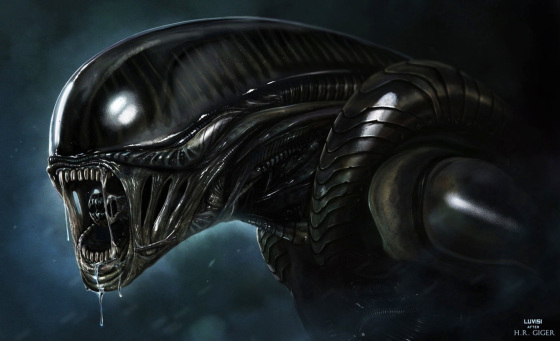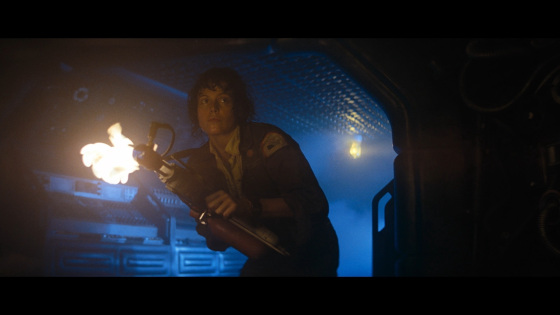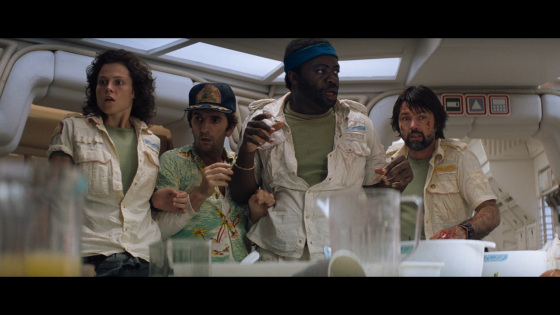commercial towing vehicle ‘The Nostromo’
crew: seven
cargo: refinery processing
20,000,000 tons of mineral ore
course: returning to earth
Ridley Scott’s “Alien” is ostensibly a “science fiction” film. AFI does list it as one of the top 10 science fiction films of all time.
But “Alien” is more than a science fiction movie, if anything it’s a genre mashup. In addition to your traditional science fiction content – space travel, cryogenic sleep, androids, alien lifeforms, etc – “Alien” is a horror movie. A monster movie. A haunted house floating through space.
And “In space no one can hear you scream.”
“Alien” is the story of a towing vessel, “The Nostromo”, and its crew. While traveling home to Earth with its cargo in tow, the ship’s artificial intelligence picks up an unidentified signal transmission and wakens the crew to investigate.
The five men and two women on board are a blue collar bunch. Though set in space, “The Nostromo” is a towing vessel, its cargo is mined ore. This crew isn’t the crew of the “Enterprise”, with historians, botanists, linguistic experts etc… They’re pilots. Mechanics. They’re employees.They’re worried about paychecks. Bonuses. They’re working class.
Relatable.
In a movie that quickly shifts into the action… I don’t think that important bit of character development should be overlooked.
The Nostromo crew diverts in order to investigate the beacon, and lands on the planet’s surface. There, they discover what appears to be a crashed spacecraft. They also discover the remains of what must have been the pilot – a large alien lifeform. Upon examination, the crew discerns his chest burst open from the inside (foreshadowing things to come).
This scene does an amazing job of establishing the mood of the movie. Dark, bleak, strange. It certainly does seem like an alien world. A frightening alien world. It amazes me, watching this film from the 1970s how great “practical” effects can be. Miniatures, models, set work… The set piece of the crash exploration is a spooky, sci-fi tone-setter: part archeological dig, part space exploration, part crime scene investigation.
Of course, the scene doesn’t end with the discovery of “the jockey”. One of the crew, Kane, investigates deeper into the ruins/wreckage. There, he discovers a chamber of pod like “eggs”. While examining one, it blossoms… and a horseshoe crab-esque creature springs forth, attaching itself to his face in spite of the visor of his spacesuit.
The horror of “Alien” begins in earnest.
Kane is taken back aboard the Nostromo over the protestations of Warrant Officer Ellen Ripley. Ripley wants to adhere to protocol and not let the crew bring Kane back on board with the “face hugger” on him. He should be quarantined for the safety of the crew. Regulations should be followed. But the Science Officer, Ash, ignores her and lets the Captain and Kane back aboard.
Kane is taken to the medical bay, where the Captain and the Science Officer attempt to determine how to remove the creature from his face. They’re immediately faced with two major obstacles. One, the alien has its tail wrapped around Kane’s throat. Injuring the creature without successfully removing it could result in it strangling him. The other is that the creature’s blood is highly acidic. A small drop of the creature’s blood, spilled in their first attempt to cut it, ate through the floor of two decks.
The horror here is multi-faceted. You have an ugly, unknown, alien parasite plus the subconscious fears of strangulation and suffocation. Just the concept of being smothered by this alien crab is terrifying. And yet they’re seemingly doomed if they harm it. They could destroy the ship if it bleeds.
The crew never gets to remove the creature. While their attention is diverted, the creature detaches itself, and dies shortly thereafter. Kane, at least for the moment, appears to have made it through the ordeal unharmed.
He hasn’t.
While eating with the crew, Kane begins to cough and then spasm. As the crew tries to hold him down and keep him from choking, a gush of blood spurts from his chest. It’s quickly followed by the emergence of a freshly born alien, which apparently incubated within his body. The alien which was recently wrapping his face laid eggs within him.
The horrified crew of the Nostromo watches in shock as the newly spawned alien dashes out of the room, leaving their dead crew-mate behind.
It’s a scene that’s achieved pop culture immortality.
The movie then enters its final phase. As the crew hunts the unaccounted for alien, the movie becomes a monster movie in space. The Nostromo crew patrol the interior of the ship cautiously, hoping at first to net the alien and force it out the airlock, as to not risk causing it to bleed. Unfortunately for them, the creature matured rapidly. By the time they begin the hunt begins, the creature is larger than a person. And it begins to kill the crew off one by one.
The setting of space comes into full play here. Gone is the typical horror movie problem – “Why don’t the just leave the house?” There’s nowhere to go, there’s no one to help. Remember, in space, no one can hear you scream.
Scott takes full advantage of the inherent claustrophobia, forcing the crew into isolated situations, and having them crawl through tight spaces and patrol narrow corridors. He uses music sparsely, relying instead on sound effects to heighten the tension. In one of the early stalking sequences, he layers in the sound of a beating heart, towards the finale it’s the sound of a ticking clock.
But it’s really the lighting of the movie which is his primary weapon. The movie is dimly lit throughout, but at times he uses strobe lighting, beams of light, whirling warning lights… it seems at times as if Scott is experimenting with ways to light a movie in order to strengthen a tone.
And they all work.
The movie has one final science fiction card to be played. When Ripley assumes command, she attempts to query the ship’s onboard computer, “Mother”, on ways to defeat the alien. It’s then she discovers that the retrieval of the creature was made the ship’s primary mission. The crew has been deemed expendable.
“Alien” has thrown a dash of conspiracy into the mix.
As Ripley attempts to leave, she is stopped by the science officer, Ash. In the ensuing struggle, Ash begins to act strangely, and sweat a strange, milky fluid. When Ripley’s surviving crew-mates arrive to aid her, Ash is hit… and his head comes off. It’s revealed that Ash is a robot. Beyond repair, head barely connected to his torso, Ash uses his final moments to express his respect for the relentless nature of the creature onboard. The crew takes a flamethrower to him.
Ripley and her two surviving crew-mates decide to set the ship to self destruct and escape in the life pod. Before they can, the creature strikes again.
The last living crewman of the Nostromo is a crew woman. Ellen Ripley.
Ellen Ripley was Sigourney Weaver’s first major film role (she had a part in “Annie Hall”). It continues to be the defining role of her career. The character of Ripley is considered to be a milestone in challenging gender roles in film. Of the crew of seven, that a woman would emerge as the victor was groundbreaking. She’s lauded as one of the greatest female protagonists of all time, and clocks in at number eight on 100 Years… 100 Heroes and Villains. Weaver would reprise the role three times.
This was Ridley Scott’s second film, also. His debut effort, 1977’s “The Duelists” won him the “Best Debut Film” at Cannes and gained the attention of producers Walter Hill, David Giler, and Gordon Carroll. They offered Scott the opportunity to direct, and Scott’s excellent storyboarding work in preproduction convinced 20th Century Fox to double the film’s budget. He in turn, created a classic film. It grossed $81 million, and was one of the highest grossing films of 1979. The sequels and related movies spawning from this film have yet to let up. Scott’s “Prometheus” is due this summer.
“Alien” is an incredible movie. It mixes successfully mixed genres to create a film which felt unique and original (it has since spawned a host of imitators). It offers the viewers the fascinations of a science fiction film, but then serves up the raw terror of a horror movie. H.R. Giger’s creature designs worked their way deep into the pop culture memory banks. The film itself has earned a place of respect among film fans, and help earn Scott his name as a great director.
It’s definitely a “Movie That Everyone Should See”.










